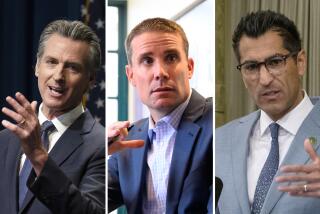Once Accused of Inactivity, Davis Now Takes Lead Role
- Share via
Just a month ago, Gov. Gray Davis was under fire for failing to move quickly and forcefully to quell California’s energy crisis.
But in recent weeks the governor has moved into campaign mode--touring power plants with TV cameras in tow and issuing a steady stream of proclamations that declare victories in the power battle.
His mission is to convince voters in California, analysts on Wall Street, and politicos across the country that he is up to solving what he insists on calling the energy “challenge.”
Davis is doing what any politician on the hustings would do: Head out to a power plant under construction as he did recently, put on a hard hat and tell gathered reporters that he is working to make sure the state will have enough power to meet its needs.
“Because it is so complicated and hydra-headed,” said Garry South, Davis’ chief political consultant, “we really felt he had to move out and simplify and objectify what he is doing.” Otherwise, people simply wouldn’t see that he had a plan to solve the problem.
“This isn’t rocket science,” South added. “The communication tools and techniques that any elected official has” don’t differ that much “from what is available in a campaign.”
Davis arrived Friday night in Washington, D.C., on the first leg of a five-day East Coast trip that will take him to Wall Street. In recent weeks, he has compiled a story to tell of actions he has taken that suggest he is on top of the situation.
Critics counter that his plans are half measures. On Friday, for example, he did not announce a final deal to rescue the state’s three private utilities from their multibillion dollar debt. Rather, he proclaimed that he had the framework of an accord with one of the utilities, Southern California Edison.
However, the goal is to show progress, even if it’s incremental.
“The public just wants it solved,” said Democratic political consultant Darry Sragow, who doesn’t work for Davis. “He is working to show that he is working to solve the problem. If there is a view that no one is solving his problem, all hell will break loose.”
The actions are a far cry from the situation in January, when utility executives, power generators and lawmakers were loudly blaming Davis for failing to recognize the power crisis and for not taking steps soon enough to get California on course for recovery.
Davis confidantes say there was no single event that led to the governor’s decision to position himself as the man who would lead California out of the crisis. But the governor pays close attention to politics--conferring at least weekly with his team of political advisors and regularly scrutinizing public opinion polls.
After convening two focus groups on the topic last month, the governor and his political advisors, led by South, concluded that Davis needed to take a higher profile. The prospect of the state’s two major utilities going broke also spurred the governor into action.
“It became important to let Wall Street, creditors, generators and the public understand that we were making progress.” said Davis’ communication director Phil Trounstine. “That’s a big piece of why you’ve seen the governor personally carrying the message.”
Davis still has critics, including many in his party. But few can say that he is still suffering from inaction. He is pushing for a state takeover--at a cost of more than $7 billion--of private utilities’ electrical transmission systems, and spending money at a clip of $1 billion a month to buy electricity.
Flush with a multibillion budget surplus, the Davis administration has spent more than $2 billion to buy electricity so far. It is offering an extra $400 million for conservation measures, and pledges to spend millions more to speed construction of new power plants.
Aides say practical reasons prevented Davis from taking a more public role sooner. He was spending most of his time gaining an understanding of the problem, and looking for solutions.
Davis was freed up only after he assembled his energy team, led by former Edison executive Michael Peevey, San Francisco lawyer Michael Kahn, and Department of Water and Power chief S. David Freeman. The trio gave Davis the expertise to negotiate with utility executives and power generators.
Once they were in place, Davis had time to make public appearances, like the one in Yuba City earlier this month, themed around generation and power plant construction--the stuff of photo opportunities.
“It was a collective view that because this problem was so complicated and abstract, he had to move out,” South said.
And of course, Davis’ political future is widely seen to ride on the outcome.
Lawmakers give Davis credit for deflecting blame for the crisis from his office, even if it means they pay the price. But now that Davis has taken the lead role, he faces risks if the plan fails.
“I’m convinced, if it blows up, he is going to get the worst of it,” said one senior Democrat.
Added Sragow: “We’re not talking about anything that is particularly subtle or sophisticated. The governor is chief executive, the point person. If the person who is the obvious choice doesn’t lead, there will be unrest, and someone will try to fill the vacuum.”
Davis’ efforts are beginning to result in some praise. A utility executive who a month ago was highly critical said after Davis announced the makings of a rescue plan for Edison that the governor “forged a difficult and creative and complex agreement.’
“I think you have to give him points for that,” the executive said.
*
This story was reported by Dan Morain in Los Angeles and Rone Tempest in Sacramento.
More to Read
Get the L.A. Times Politics newsletter
Deeply reported insights into legislation, politics and policy from Sacramento, Washington and beyond. In your inbox three times per week.
You may occasionally receive promotional content from the Los Angeles Times.










